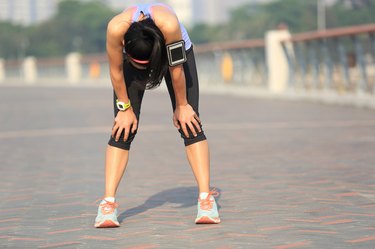
Often the point of exercise is to get your heart rate up; however, you need to keep it within safe limits. Letting your heart rate get too high for too long can harm your body and make you feel nauseous. Nausea during exercise can also happen because you do not allow your body enough time to digest meals before exercising. Nausea and an excessive heart rate during exercise can also signify health problems that warrant a doctor visit if they persist.
Basics
Video of the Day
Generally, you want to get your heart rate to at least half of your maximum for your workout to be effective. When you keep using your muscles in an aerobic exercise such as jogging, your heart needs to beat faster and harder to deliver oxygen-rich blood to your muscles to keep you going. This exercises your heart just as it exercises the muscles in your legs -- making your heart beat faster makes it stronger. However, it can be dangerous to let your heart rate go above 85 percent of your maximum heart rate. This upper limit translates to 162 beats per minute for a 30-year-old, 153 beats per minute for a 40-year-old and 145 beats per minute for a 50-year-old.
Video of the Day
Over-Training
If you feel nauseous during or after your workouts, it may be a sign that you overdid it. People often report feeling nauseous when they over-train, according to R.W. Fry and colleagues in a September 1994 article in the British Journal of Sports Medicine. Ensure that you do not get sick from over-training by verifying that your heart rate is not above 85 percent of your maximum heart rate. If you do not want to stop to measure your pulse, a good rule of thumb is that if you have to stop repeatedly to catch your breath, you are working too hard.
Eating Before Exercise
Eating too soon before you exercise may worsen or even cause your feelings of nausea, according to T. Kondo and colleagues in a 2001 article in the journal Appetite. Kondo and colleagues had people perform exercise at 40 to 50 percent or 70 to 80 percent of their maximum heart rates immediately after eating. People felt more nauseous if they exercised at a high intensity right after eating than if they exercised at a low intensity. Wait three or four hours after large meals before you exercise, to help cut down on your feelings of nausea.
Warning
Nausea during or after exercise may also be a sign of a hormone disorder called pheochromocytoma. Symptoms of pheochromocytoma include a high heart rate along with headaches, sweating, chest pain and feelings of anxiety. People with pheochromocytoma often feel nauseous and vomit after exercise. Consult your doctor if your nausea and high heart rate during exercise persists despite lowering the intensity of your workout and waiting three or four hours after meals to work out.
- American Heart Association: Target Heart Rates
- "British Journal of Sports Medicine"; Psychological and Immunological Correlates of Acute Overtraining; R. W. Fry, et al.; September 1994
- PubMed.gov: Exercise-Induced Nausea Is Exaggerated by Eating
- MayoClinic.com: Eating and Exercise: 5 Tips to Maximize Your Workouts
- Medline Plus: Pheochromocytoma
- PubMed.gov: Exercise-Induced Nausea and Vomiting: Another Sign and Symptom of Pheochromocytoma and Paraganglioma